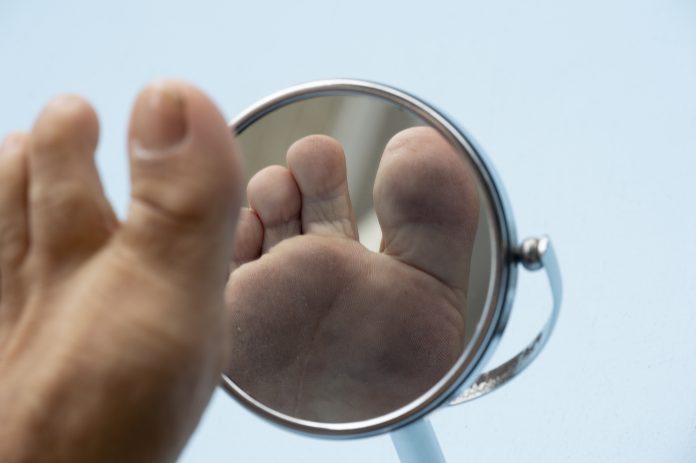Here, the iDEAL Group discuss the importance of foot care in diabetes and what can be done to improve the outcomes of patients’ health
There were a staggering 7,545 major amputations in people with diabetes in England between 2015 to 2018. The amputation rate (standardised for age and ethnicity) per 10,000 people living with diabetes was 8.2, and this has remained largely static since 2013. (Diabetes Foot Care Profiles April 2019 (Public Health England) With more than 4 million people currently living with diabetes in the UK and a further 12 million at high risk of developing the condition, the personal, social and fiscal costs of diabetes-related amputations are too high. In 2014-15, diabetes-related foot care consumed nearly 1% of the entire NHS budget – almost £1 billion (Kerr et al, 2019). We urgently need to reduce the rate of amputations for people with diabetes, and we need to do it now.
The progression from an initial foot ‘scratch’ to major tissue destruction can be as little as 48 hours; reaching a specialist healthcare professional quickly is essential. There are two reasons, however, why this may not happen:
-
Delays to accessing specialist care
Access to a multidisciplinary foot team (MDFT)may be too late due to delays by the PLwD in seeking and reaching care, delays by HCPs in referring to specialist care or delays in accessing care in the MDFT once a referral has been made.
In a systematic review of the identification, causes, and outcomes of delays in the management of chronic limb-threatening ischemia and foot ulceration in PLwD, Nickinson et al (2019) found that “median times from symptom onset to specialist health care assessment ranged from 15 to 126 days, with subsequent median times from assessment to treatment ranging from 1 to 91 days”. This delay may occur because the person living with diabetes has not recognised the seriousness of a break in the skin, discharge, redness or swelling.
iDEAL proposes the establishment of a national education programme with practical information in an illustrated practical handout for all PLwD about foot self-care and checks from diagnosis onwards are needed. This information must be made easily accessible in National diabetes-related websites (for example Diabetes UK, JDRF, NHS, TREND) and in all GP surgeries and all pharmacies.
A national campaign similar to the campaigns that informed heart attack and stroke (which had the acronyms STOP and FAST) is also required. A mnemonic campaign should help detect and enhance the responsiveness to the warning signs displayed by a PLwD. The iDEAL Group suggests “ACT NOW”.
Health Commissioners and Providers should then facilitate the option of self-referral by PLwD directly into their local MDFT, which is likely to increase the total number of referrals into the MDFT. Although this will facilitate more rapid assessment and treatment of foot ulcers with subsequent greater and prompter ulcer healing it will increase demand for podiatrists within the diabetes foot service, and so the Government must urgently review the decision to remove the NHS student bursaries into podiatry to improve recruitment into this discipline.
From the healthcare professional’s perspective, Manu et al (2018) concluded in a study of health care systems that “Despite differences in healthcare structures across Europe, delays in referral to specialist foot care teams seems to be a common theme. There is an ongoing need to educate GP’s, nurses and patients to be more aware of the risk of DFU (diabetic foot ulcer), and the need for prompt referral to specialist diabetes foot teams.”
-
Unavailability of optimal specialist care
The unavailability of optimal specialist care because of the absence of a multidisciplinary foot team in the local acute hospital can also create a barrier to improved outcomes.
The National Diabetes Inpatient Audit (NaDIA) (2018) which covered the structures of care that are fundamental to achieving the standards of safe effective inpatient diabetes care reported that one-sixth of hospital sites (17.3%) did not have an MDFT (NaDIA, 2018).
In line with NICE Guidelines NG19 (2015, updated in 2019), there should be MDFT provision in every acute hospital. A supplementary part of the Diabetes transformational campaign would be to make sure that there is an active credible MDFT in each NHS trust, to which there is ready access by PLwD and foot problems.
NICE NG19 ( 2015 updated in 2019) also advocated that a PLwD who has a limb-threatening or life-threatening foot problems, such as ulceration with limb ischaemia or with fever or any signs of sepsis or a deep-seated soft tissue or bone infection or gangrene, should be referred immediately to the acute services and the multidisciplinary foot care service be informed.
For all other active diabetes-related foot problems, the PLwD should be referred within one working day to the MDFT or foot protection service (according to local protocols and pathways) for triage within one further working day.
The impact: halving the number of amputations
Once a person living with diabetes reaches an MDFT, individual outcomes are expected to improve, the number of major amputations should be reduced and savings should be generated for the NHS. Our campaign, for people living with diabetes and their healthcare professionals to be better able to recognise foot problems and then be able to rapidly access expert care from an MDFT, has a target to reduce the number of major amputations by at least 50% over 5 years.
The cost of inpatient care for major amputations in 2014-2015 was £24.8 million; achieving this target would save the health service over £12 million. The costs of failing to ACT NOW, meanwhile, will be far higher.
References
Diabetes Foot Care Profiles April 2019 (Public Health England) https://fingertips.phe.org.uk/profile/diabetes-ft
Kerr M, Barron E, Chadwick P, Evans T, Kong WM, Rayman G, Sutton-Smith M, Todd G, Young B, Jeffcoate W The cost of diabetic foot ulcers and amputations to the National Health Service in England J.Diabet Med. 2019 Aug;36(8):995-1002. doi: 10.1111/dme.13973.
Manu C, Lacopi E, Bouillet B, Vouillarmet J, Ahluwalia R, Lüdemann C, et al. Delayed referral of patients with diabetic foot ulcers across Europe: patterns between primary care and specialised unitsJ Wound Care, 27 (2018), pp. 186-192
National Diabetes Inpatient Audit (NaDIA) – 2018 published 9th May 2019.
NHS Digital (2019) National Diabetes Footcare Audit (NDFA). Fourth Annual Report England and Wales 2019
NICE NG19 (2019) Diabetic Foot problems: prevention and management, https://www.nice.org.uk/guidance/ng19
Nickinson ATO, Bridgwood B, Houghton JSM, Nduwayo S, Pepper C, Payne T, Bown MJ, Davies RSM, Sayers RD. A systematic review investigating the identification, causes, and outcomes of delays in the management of chronic limb-threatening ischemia and diabetic foot ulceration. J Vasc Surg. 2019 Oct 29. pii: S0741-5214(19)32170-6. doi: 10.1016/j.jvs.2019.08.229.











